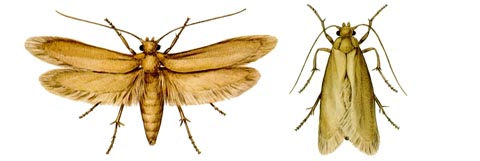Clothes Moths

Clothes Moths
Moths digest keratin, the “hard” protein of which hair, horns, nails, claws, hoofs, feathers, and scales of reptiles, birds, and mammals are formed. All of these make up natural clothing that we wear. Moths also attack a wide variety of other natural materials and some synthetic ones as well. They often use paper, starch, cotton or silk to build cocoons. It is the larvae of clothes moths that attack fabrics. In the house, they feed on wool, hair, or feather products wherever they have access to them. Clothing, carpets, furs, blankets, upholstery, piano felts, brush bristles, and lots of other items are subject to their attack. They also feed on synthetic fabrics and fabrics from botanical sources if they are mixed with wool. The larval stage lasts for one to three months.
Clothes moths dislike direct sunlight. Moths cannot complete their normal life cycle on clean, processed wool. It must be contaminated with some nutritional supplement such as food, beverage, sweat or urine stains. Such stains provide the proteins, the mineral salts and the vitamin B complex essential to the moth.
Clothes moth larvae chew holes in fabrics. The holes appear to be scattered about the garment and are generally small. (Carpet-beetle holes, on the other hand, usually seem to be concentrated in a few areas and can be quite large.)
Clothes moth larvae prefer to feed in protected locations such as under collars, inside hems, on the backside, or in cracks at the edges of woolen carpets, under furniture, and inside storage containers.
We use a combination of two methods. Pheromone traps and IGR’s:
What is a IGR?
- Insect Growth Regulators (IGR’s).
- It works by disrupting the growth and development processes specific to insects.
- It causes sterilization of adult insects.
- The active ingredient is Hydroprene.
Click On The Pest Category To Learn More.
| Bedbug Guide | House Centipedes |
| Carpenter Ants | Mosquitoes |
| Clothes Moths | Roaches |
| Fly Facts | Ants vs Termites |
| Little Black Ant | Termites |
| Odorous House Ant | House Flies |
| Fruit Flies | Rodents |






